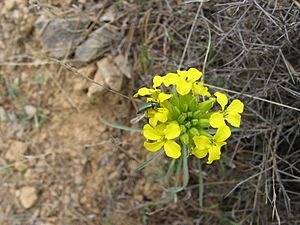Erysimum nevadense facts for kids
Quick facts for kids Erysimum nevadense |
|
|---|---|
 |
|
| Scientific classification | |
| Genus: |
Erysimum
|
| Species: |
nevadense
|
Erysimum nevadense is a special type of plant that lives for a few years. It's a herb, which means it has soft stems, not woody ones like trees. This plant is only found in the Sierra Nevada mountains in Spain, and sometimes in the nearby Sierra de Gádor area. It grows high up in the mountains, usually between 1,700 and 2,700 meters (about 5,500 to 8,800 feet) above sea level. You can find it in rocky areas and mountain meadows. Scientists sometimes see it as one unique species, or as part of a group of six similar species, or even as one big species with six different types (called subspecies).
Contents
What it Looks Like
Erysimum nevadense, also known as the Nevada Wallflower, is usually a biennial (lives for two years) or a perennial plant (lives for more than two years). It often has many branches with several flowering stems. These stems are usually shorter than 25 cm (10 in) (about 10 inches) tall.
Leaves and Flowers
The plant is covered in tiny hairs, which can make its leaves look a bit grey-green. These leaves are long and narrow, typically 20–60 cm (8–24 in) (about 8 to 24 inches) long and only 1–3 mm (0.0–0.1 in) (less than a tenth of an inch) wide.
The flowering stems themselves are 2–15 cm (0.8–5.9 in) (about 1 to 6 inches) long, not counting the cluster of flowers at the top. Each flower has bright yellow petals that are 12–16 mm (0.5–0.6 in) (about half an inch) long and 3–4 mm (0.1–0.2 in) (about a tenth of an inch) wide. After the flowers bloom, they produce fruits that stand upright or hang down. These fruits are usually shorter than 4 cm (1.6 in) (about 1.5 inches) long and grow on small stalks called pedicels, which are up to 6 mm (0.2 in) (about a quarter of an inch) long.
How Scientists Classify This Plant
Naming the Plant
Erysimum nevadense was first officially described by a scientist named Georges François Reuter in 1855. This is how plants get their scientific names.
Different Ideas About Its Family
Later, in 1979, another scientist, Adolf Polatschek, found several new types of Erysimum plants. Six of these seemed very similar to E. nevadense. Because they were so alike, in 1990, Peter William Ball suggested that these six types should be considered "subspecies" of E. nevadense. A subspecies is like a special group within a species.
However, other scientists disagreed. In 1993, in a big plant book called Flora Iberica, these six types were treated as completely separate species, not just subspecies.
Modern Research
More recently, in 2014, scientists used DNA studies to look at how these plants are related. They studied four of the species that were thought to be closely related: E. gomez-campoi, E. mediohispanicum, E. nevadense, and E. rondae. The DNA results showed that these four plants might not be as closely related as once thought. This means the idea of them all being part of one "nevadense group" might not be correct.
Subspecies of Erysimum nevadense
Even with the new DNA findings, some plant databases, like Plants of the World Online, still list Erysimum nevadense as having six subspecies. Remember, these are the same plants that Flora Iberica treats as separate species.
- Erysimum nevadense subsp. fitzii = Erysimum fitzii
- Erysimum nevadense subsp. gomez-campoi = Erysimum gomez-campoi
- Erysimum nevadense subsp. mediohispanicum = Erysimum mediohispanicum
- Erysimum nevadense subsp. merxmuelleri = Erysimum merxmuelleri
- Erysimum nevadense subsp. nevadense = Erysimum nevadense (the main type)
- Erysimum nevadense subsp. rondae = Erysimum rondae
Pollination and Life Cycle
How Flowers Get Pollinated
The flowers of Erysimum nevadense are very popular with many different kinds of insects! These insects help the plant make seeds by carrying pollen from one flower to another. This process is called pollination.
Many insects from different groups visit the flowers, including:
- Hymenoptera (like bees and ants)
- Diptera (like flies)
- Coleoptera (like beetles)
- Lepidoptera (like butterflies and moths)
- Heteroptera (true bugs)
Important Insect Visitors
Some of the most common visitors to the flowers are:
- Proformica longiseta: This is a type of ant found only in the Sierra Nevada mountains.
- Dasytes subaeneus and Malachius laticollis: These are types of beetles.
- Bombylius and Parageron species: These are types of beeflies, which look a bit like fuzzy bees.
These insects play a vital role in the plant's life cycle by helping it reproduce.
See also
 In Spanish: Erysimum nevadense para niños
In Spanish: Erysimum nevadense para niños

